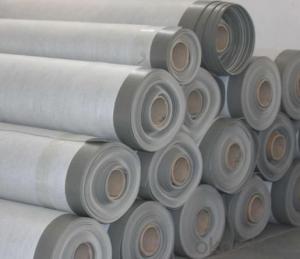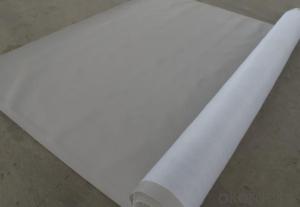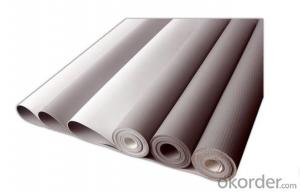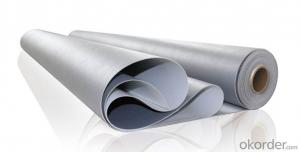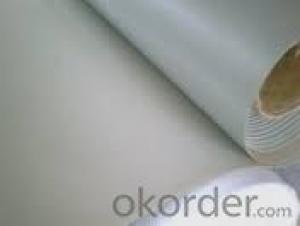PVC Punched Waterproofing Membrane for Underground
- Loading Port:
- China main port
- Payment Terms:
- TT OR LC
- Min Order Qty:
- 5000 m²
- Supply Capability:
- 100000 m²/month
OKorder Service Pledge
OKorder Financial Service
You Might Also Like
Product description of PVC Waterproofing Membrane:
The flexible roofing system has been mature history for several years in the world, especially in the large workshop, warehouse, logistics and other roof has been widely used. Its structure is simple and clear: pressure plate structure of gas isolation - insulation waterproof, each function of each level divided the whole roof; waterproof layer for the whole roof from the erosion of rainwater, so waterproof material excellent in the flexible roofing.
Our EPDM waterproofing membrane, is one of the world's advanced waterproof material, it not only has three Yuan rubber weather resistance, good aging resistance; lap joint can also be hot air welding, overcomes three EPDM coiled material adhesive construction is complex, so that the joint is more solid water quality is more reliable.
Product features
The physical and mechanical properties of stability, durability and anti ageing capacity is good, its oil and solvent resistance and general-purpose chloroprene rubber be roughly the same.
1 Good heat resistance, cold resistance, can be in (-60-150 C) within the scope of use.
2 Extension and rate very high tear strength, shrinkage cracking of buildings or a strong ability to adapt.
3 The proportion of light (0.90~0.97), the appearance of uniform quality, has good flexibility and elasticity.
4 Good weldability, materials can be directly welded, is conducive to ensure weld quality. After welding to form an integral waterproof layer.
5 Good dimensional stability, heat shrinkage is small, the deformation is small, keep a good state during construction.
6 Environmental protection type. Does not produce harmful substances in the production, construction and use of the process, and can be recycled, does not produce construction waste.
Application arrange
Applicable to all kinds of roofing, basement, tunnel, building waterproof engineering; civil and industrial building roofs and underground engineering, municipal, bridges, storage tank,
Waterproof subway, tunnel, dam engineering, especially suitable for durability, corrosion resistance requirements and easy deformation of the key waterproof engineering.
Specification of PVC Waterproofing Membrane:
No. | Item | Model Ⅱ | |
1 | Tensile Strength Mpa ≥ | 12.0 | |
2 | Elongation at break% ≥ | 250 | |
3 | Shrinkage rate % ≤ | 2.0 | |
4 | Flexibility at low temperature | No crackle at -25oC | |
5 | Water tightness | Watertight | |
6 | Puncture resistance | Watertight | |
7 | Heat aging treatment | Appearance | Free from bubble, crack, cohesion and void |
Change rate of tensile strength % | +20oC | ||
Change rate of elongation at break | |||
Flexibility at low temperature | No crack at -20oC | ||
8 | Chemical corrosion resistance | Change rate of tensile strength % | +20 |
Change rate of elongation at break | |||
Flexibility at low temperature | No crack at -20oC | ||
9 | Artificial weathering | Change rate of tensile strength % | +20 |
Change rate of elongation at break | |||
Flexibility at low temperature | No crack at -20oC | ||
Remark: The property of artificial weathering might not be applicable to non-exposed product | |||
FAQ of PVC Waterproofing Membrane
a.Can we get some samples before place order?
Answer: We can send the free samples to you by freight collect.
b.How many years can your PVC membrane guarantee?
Answer: We will guarantee the quality for 5 years at least.
c.Which countries you ever export the product?
Answer: We export the PVC membrane to South Africa, Middle east and even European countries.
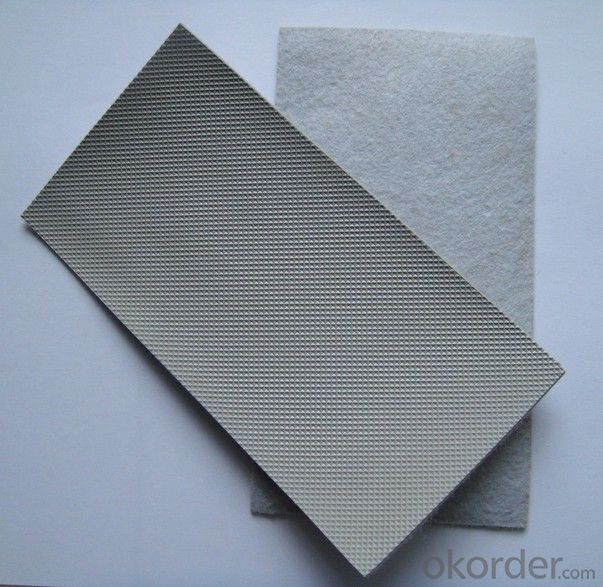
- Q: Can a waterproofing membrane be used on stone block surfaces?
- Yes, a waterproofing membrane can be used on stone block surfaces. The membrane creates a protective barrier that prevents water penetration and helps to maintain the integrity of the stone blocks. However, it is essential to ensure that the appropriate type of waterproofing membrane is selected and installed correctly to ensure proper adhesion and durability on the stone surface.
- Q: Can a waterproofing membrane be used in conjunction with soundproofing materials?
- Yes, a waterproofing membrane can be used in conjunction with soundproofing materials. In fact, it is quite common to use both of these materials together in construction projects. Waterproofing membranes are typically used to prevent the penetration of water into a structure, while soundproofing materials are used to reduce noise transmission. These two materials serve different purposes but can be used simultaneously to provide both waterproofing and soundproofing benefits. For example, in a building with a basement or a bathroom, a waterproofing membrane can be installed on the walls or floors to prevent water infiltration, and then soundproofing materials can be added on top of the membrane to reduce noise transmission from adjacent areas. By combining these two materials, a building can be protected from water damage while also providing a quieter and more comfortable environment for its occupants.
- Q: Can a waterproofing membrane be used for elevator shafts?
- A waterproofing membrane is an effective solution for elevator shafts. Elevator shafts are prone to water infiltration, which can harm the building's structure and the elevator system itself. By using a waterproofing membrane, water can be prevented from entering the shaft, safeguarding it against moisture-related issues such as corrosion, mold, and mildew. Typically, the membrane is applied to the shaft's walls and floors, creating a barrier that blocks water. To ensure optimal effectiveness and durability, it is important to select a waterproofing membrane specifically designed for elevator shafts. Moreover, proper installation and maintenance are crucial for the long-term performance of the waterproofing system. In conclusion, employing a waterproofing membrane for elevator shafts is a recommended measure to shield against water damage and uphold the elevator system's functionality and safety.
- Q: Can a waterproofing membrane be used in rooftop gardens or green roofs?
- Yes, a waterproofing membrane can be used in rooftop gardens or green roofs. It is an essential component to prevent water leakage and protect the underlying structure from moisture damage. The membrane acts as a barrier, preventing water from penetrating the roof and causing potential structural issues. This ensures that the rooftop garden or green roof remains well-maintained and functional.
- Q: Can a waterproofing membrane be used for plaza decks?
- Yes, a waterproofing membrane can be used for plaza decks. Waterproofing membranes are commonly used in construction to prevent water infiltration and protect the underlying structure. Plaza decks are outdoor spaces that require protection against water damage, making waterproofing membranes an ideal solution to ensure the longevity and durability of the deck.
- Q: Can a waterproofing membrane be used for a hospital?
- Yes, a waterproofing membrane can be used for a hospital. Waterproofing membranes are commonly used in hospitals to prevent water infiltration and protect the building from water-related damages. They are especially useful in areas with high moisture levels such as bathrooms, basements, and roofs. By installing a waterproofing membrane, hospitals can ensure a dry and safe environment for both patients and staff, reducing the risk of mold, mildew, and structural deterioration caused by water damage.
- Q: What is the difference between construction non-vulcanized waterproofing membrane and vulcanized waterproofing membrane?
- Non-vulcanized rubber waterproofing membrane: from SR or SR and asphalt blends by mixing, rolling made of coil, without vulcanization can use the product. The bonding between the coils and their bonding properties with the mortar is good, the manufacturing is convenient, the price is low, but the tensile strength is low. Can be divided into two types of rubber and rubber asphalt. Rubber type commonly used SBR and other SR production. Generally used for civil construction roof waterproof.
- Q: Can a waterproofing membrane be used for podium decks or plaza areas?
- Yes, a waterproofing membrane can be used for podium decks or plaza areas. Waterproofing membranes are commonly used in construction to prevent water penetration and protect the underlying structure from moisture damage. In outdoor areas like podium decks or plaza areas, where exposure to rain or other forms of water is common, a waterproofing membrane can provide an effective barrier against water infiltration and help maintain the integrity of the deck or plaza surface.
- Q: Can a waterproofing membrane be used on precast concrete block surfaces?
- Precast concrete block surfaces can benefit from the application of a waterproofing membrane. These membranes are commonly used to safeguard below-grade structures, like basements and foundations, from water infiltration. When constructing these structures, precast concrete blocks are frequently utilized, and the use of a waterproofing membrane can prevent water from seeping into the concrete and causing harm. The membrane acts as a barrier, prohibiting water from passing through while still allowing the concrete to breathe and release any accumulated moisture. Furthermore, waterproofing membranes can enhance the overall durability and lifespan of precast concrete blocks by shielding them from moisture-related problems such as cracking, spalling, and corrosion. It is crucial to select a waterproofing membrane that is specifically designed for below-grade applications and is compatible with concrete surfaces to ensure proper adhesion and long-term efficacy.
- Q: Can a waterproofing membrane be used for a garden pond liner?
- Certainly! A garden pond liner can be made using a waterproofing membrane. The primary purpose of a waterproofing membrane is to stop water from seeping through it, which makes it a great option for constructing a garden pond with a tight seal. By using a waterproofing membrane, leaks can be effectively prevented, guaranteeing that the water remains within the pond. Moreover, waterproofing membranes are generally long-lasting and can withstand UV rays, chemicals, and punctures, all of which are essential considerations when choosing a material for a pond liner. Nonetheless, it is vital to ensure that the selected waterproofing membrane is specifically designed for pond use and is safe for aquatic life.
Send your message to us
PVC Punched Waterproofing Membrane for Underground
- Loading Port:
- China main port
- Payment Terms:
- TT OR LC
- Min Order Qty:
- 5000 m²
- Supply Capability:
- 100000 m²/month
OKorder Service Pledge
OKorder Financial Service
Similar products
Hot products
Hot Searches
Related keywords
